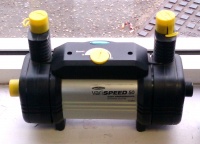Difference between revisions of "Pumps"
Jump to navigation
Jump to search
(→More Head Please: link) |
(m →See Also) |
||
| (7 intermediate revisions by the same user not shown) | |||
| Line 3: | Line 3: | ||
==Flow & Head== | ==Flow & Head== | ||
| − | + | Maximu flow rate occurs with no resistance, ie no pipe attached to the output, and maximum head figure occurs at about zero flow. | |
* The pump often operates against a column of water (or head) which provides back pressure | * The pump often operates against a column of water (or head) which provides back pressure | ||
* Pipes have resistance to water flow | * Pipes have resistance to water flow | ||
| − | + | Real life flow can be determined by plotting head (at zero flow) versus flow rate (at zero head) on x & y axes, and drawing a line from max flow to max head. This enables approx flow rates to be read off for any given head. [http://www.pricepump.com/pumpschool/psles2.html Pump curves page] explains this. | |
[http://groups.google.com/group/uk.d-i-y/browse_frm/thread/f73a5b1271ece66c# More info] | [http://groups.google.com/group/uk.d-i-y/browse_frm/thread/f73a5b1271ece66c# More info] | ||
| Line 17: | Line 17: | ||
==Pump Materials== | ==Pump Materials== | ||
| − | * | + | * Bronze: used for potable water & unsealed uninhibitied CH |
* Plastics: some are approved for potable water | * Plastics: some are approved for potable water | ||
| + | * Iron/steel: for central heating where oxygen is excluded or inhibitor used | ||
==Connections== | ==Connections== | ||
| Line 24: | Line 25: | ||
==Pump Types== | ==Pump Types== | ||
===Central Heating circulator=== | ===Central Heating circulator=== | ||
| − | |||
| − | |||
* Speed adjustable. | * Speed adjustable. | ||
** too fast can cause pumping over & noise | ** too fast can cause pumping over & noise | ||
** too slow can cause boiler kettling | ** too slow can cause boiler kettling | ||
| − | + | ||
| + | Smart pumps adjust speed according to the primary water temp. The pumping energy they save in their lifetime is similar in price to the extra purchase cost. | ||
===Shower=== | ===Shower=== | ||
| + | [[image:IMAG3352-3 shower pump.jpg|right|200px]] | ||
| + | |||
* Boost shower pressure and thus flow | * Boost shower pressure and thus flow | ||
| − | * | + | * Boost bills too |
| + | * Place on a soft pad to reduce noise | ||
===Sump pump=== | ===Sump pump=== | ||
| Line 52: | Line 55: | ||
* [[Plumbing]] | * [[Plumbing]] | ||
* [http://groups.google.co.uk/group/uk.d-i-y/browse_frm/thread/b16121a43cb1d242/c03ea54830283a48?tvc=1#c03ea54830283a48 article discussed on news:uk.d-i-y] | * [http://groups.google.co.uk/group/uk.d-i-y/browse_frm/thread/b16121a43cb1d242/c03ea54830283a48?tvc=1#c03ea54830283a48 article discussed on news:uk.d-i-y] | ||
| + | * [http://yaph.co.uk/blog/201401_pump_figures/ smart pump savings] | ||
| + | * [[Central heating pump repair]] | ||
* [[Special:Allpages|Wiki Contents]] | * [[Special:Allpages|Wiki Contents]] | ||
* [[Special:Categories|Wiki Subject Categories]] | * [[Special:Categories|Wiki Subject Categories]] | ||
Latest revision as of 03:49, 10 January 2018
All about pumps. Please contribute & help complete the article.
Flow & Head
Maximu flow rate occurs with no resistance, ie no pipe attached to the output, and maximum head figure occurs at about zero flow.
- The pump often operates against a column of water (or head) which provides back pressure
- Pipes have resistance to water flow
Real life flow can be determined by plotting head (at zero flow) versus flow rate (at zero head) on x & y axes, and drawing a line from max flow to max head. This enables approx flow rates to be read off for any given head. Pump curves page explains this.
More Head Please
Plumbing 2 pumps in series increases the flow rate as shown here: Pumps in series
Pump Power
Pump Materials
- Bronze: used for potable water & unsealed uninhibitied CH
- Plastics: some are approved for potable water
- Iron/steel: for central heating where oxygen is excluded or inhibitor used
Connections
Pump Types
Central Heating circulator
- Speed adjustable.
- too fast can cause pumping over & noise
- too slow can cause boiler kettling
Smart pumps adjust speed according to the primary water temp. The pumping energy they save in their lifetime is similar in price to the extra purchase cost.
Shower
- Boost shower pressure and thus flow
- Boost bills too
- Place on a soft pad to reduce noise
Sump pump
- For draining cellars prone to flooding.
- Usually automatically operated by a built-in water sensor
- Usually placed in a small dug out lowered area of floor to achieve good floor drainage.
Drill Pump
- Small minimal cost pump for occasional clear-up use
Foul Water Pump
- Able to handle debris in the water
